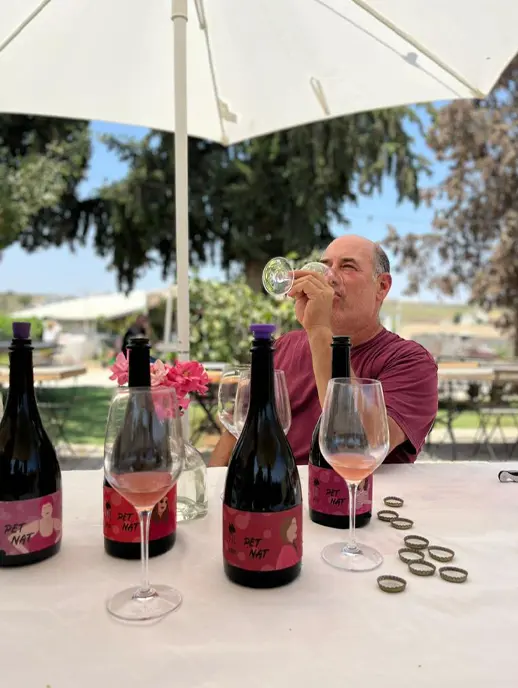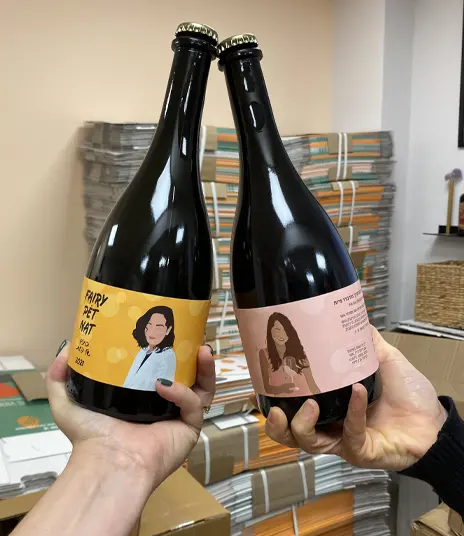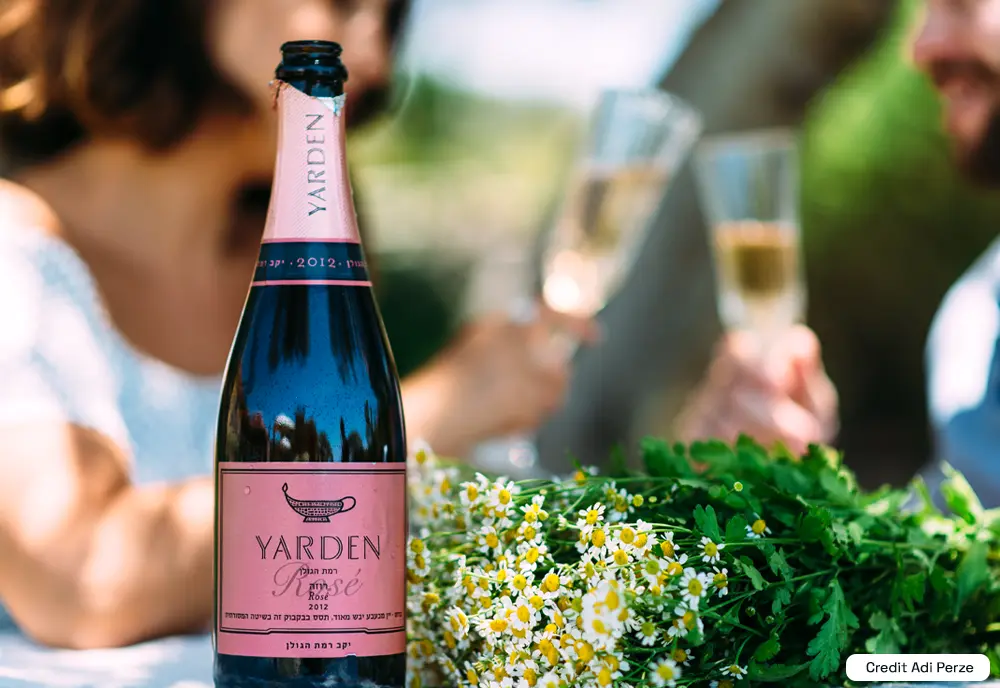New Year’s Eve, Sylvester’s or Novy God, are all reasons or excuses to drink sparkling wine. This is the wine of celebration symbolizing happiness and joie de vivre. The prime quality representative of this sector has always been Champagne, made in the Champagne region of France by the ‘Champagne Method’. The image of real Champagne does have a certain magic and stardust about it.
A version of this article was published in the Jerusalem Post.
This way of making the best sparkling wines has spread to most wine producing countries, including Israel, where they call it the Classic or Traditional Method. It involves inducing a secondary fermentation in the bottle that you drink, by adding sugar and yeast. Going down the scale of quality and price, then there is sparkling wine made by the Cuve Close or Charmat Method, where the second fermentation occurs in a tank and then the wine is bottled under pressure to preserve the bubbles. Finally, is the most inexpensive way to make a wine sparkle, which is what I call the ‘Coca Cola Method’, whereby carbon dioxide is simply injected into the wine.
The famous wines with bubbles include names which trip off the tongue, like Champagne, Cava, Prosecco, Lambrusco, Moscato and there are others. These cover the quality and price spectrum, and all are good fodder for end of year celebrations. You just choose your poison based on personal preferences of price, style, sweetness and image.
 There is a new kid on the block, which paradoxically is older than all the sparkling wines mentioned. This is the Pet-Nat, which is an abbreviation for Petillant Naturel. These wines are made by what is called the Ancestral Method and undergo one fermentation only, with the winemaker bottling it before the fermentation is finished. The bubbles produced during fermentation are trapped in the wine.
There is a new kid on the block, which paradoxically is older than all the sparkling wines mentioned. This is the Pet-Nat, which is an abbreviation for Petillant Naturel. These wines are made by what is called the Ancestral Method and undergo one fermentation only, with the winemaker bottling it before the fermentation is finished. The bubbles produced during fermentation are trapped in the wine.
This method of winemaking was discovered in the 16th century in France totally by accident. The wine would be made as normal after the harvest. It would rest quietly during the cold winter months. On the onset of Spring, as temperatures warmed up, the yeast left in the wine would wake up, nudge its yeasty companions, and go and feast on the unfermented sugar left in the wine. The winemaker would wake up one day and be surprised to find out that he had a sparkling wine.
The idea was revived in the 1990’s in the Loire Valley. A curious winemaker bottled a still wine, which later began fermenting in the bottle. He tasted it, found it intriguing. He did some research, discovered Ancestral Method wines and then started his own experiments, learning from trial and error. In the last decade, the Pet-Nat revolution took root, and then spread like a rash.
Pet-Nats are fun, fresh, irreverent, natural, inexpensive and relatively low alcohol (10-11% Alcohol). The taste can be funky and will likely be differ from bottle to bottle. The sweetness can vary from bone dry to off dry, but each bottle is a world in itself. They may be cloudy (as they are unfiltered) and volatile, hence why they use a beer crown cap as a bottle closure. They have the benefit of being the new ‘in’ thing, but also appeal to those who support natural wines, bereft of additives, or those that want to recreate ancient winemaking methods.
The winery that has become the main Pet-Nat specialist in Israel, is Kerem Barak Winery in the Judean Foothills, owned by Yossi and Yael Rosenberg. He learnt his trade at the Soreq Wine School and at a winemaking course at Tel Hai College. He started making wine in the early 2000’s and in 2012 founded his winery, which is named after their son, Barak, who passed away tragically, far too young. Yossi learnt about Pet-Nats from another winemaker, became infatuated with the idea and concept, and went Pet-Nat crazy. One year the winery made twenty different Pet-Nat wines. Rosenberg explained he loves to capture the unique aromas of a white wine during fermentation. That does not mean he is bound to one style or one grape variety. Far from it, in fact the opposite is the case. He makes Pet-Nats from everything and anything! There are white, orange (a white wine variety, fermented with its skins like a red wine), rose and red Pet-Nats. They make them with classic varieties (like Chardonnay & Syrah), with what I call adopted varieties (like Colombard and Carignan) and local varieties (like Dabouki and Bittuni.) The result in terms of color and taste covers a large spectrum. There is no standard. Making Pet-Nats is not an exact science. By the way, for the last two vintages, Kerem Barak’s wines are certified Kosher by Tzohar. Provocative to some, a blessing to others but certainly interesting!
 Pet-Nats are drinking wines. These are not wines to analyze and talk about with hushed tones. You will not write copious tasting notes comparing the nuance in different expressions. They are spontaneous, knee jerk wines, also known as hipster’s champagne, or beer drinker’s sparkling wine. Kerem Barak Winery recently organized a formal tutored tasting of their wines, and we enjoyed vertical (same variety, different vintages) and horizontal flights (different varieties, same year), but though interesting, it seemed a contradiction in terms. These are mood wines, not wines to take too seriously.
Pet-Nats are drinking wines. These are not wines to analyze and talk about with hushed tones. You will not write copious tasting notes comparing the nuance in different expressions. They are spontaneous, knee jerk wines, also known as hipster’s champagne, or beer drinker’s sparkling wine. Kerem Barak Winery recently organized a formal tutored tasting of their wines, and we enjoyed vertical (same variety, different vintages) and horizontal flights (different varieties, same year), but though interesting, it seemed a contradiction in terms. These are mood wines, not wines to take too seriously.
To produce Pet-Nats is also good for cash flow. No aging in barrel and then bottle, waiting for the wine to mature and be ready to drink. What you have, you can sell pretty quickly. Kerem Barak Winery also has a masterful marketing idea. The wines have bright labels, designed and drawn by Yossi’s artistic daughter, Hilla. They show illustrations of trendy, young hip figures of the Tel Aviv wine intelligencia. Apart from being totally original, the person who is the subject of the label, has the fun and motivation of helping to sell their own wine!
Some of my favorite Pet-Nats include:
Kerem Barak Winery, Pet-Nat French Colombard 2021. Colombard is a good variety for Israel. It has great acidity and as attractive floral aroma. Of all the Pet-Nats we tasted of Kerem Barak Winery, I thought it was the best balanced, with a beginning, middle and end.
Vortman Pet-Nat Rose 2021. Made from Petit Verdot grapes grown in Shefaya, in the Coastal Plain region, near Zichron. The use of Petit Verdot is a surprise…and it works. It is fresh, with flavor and length. Most striking is its texture, one of the characteristics which are most attractive in Pet-Nats.
Dalton Pet-Nat is made by Dalton Winery, who make sparklers across the spectrum. They also produce a traditional method sparkling wine and a Moscato. This Pet-Nat is made Semillon from the Galilee and Muscat from Judea. It is fresh, fruity and aromatic. Delightfully unpretentious, it is a wine to serve chilled and glug.
Of course many will prefer a traditional sparkling wine. For years only the Golan Heights Winery made quality sparkling wines under their Yarden and Gamla labels. Now many other wineries are making traditional method sparkling wines including the aforementioned Dalton, Ella Valley, Pelter, Psagot, Razi’el, Sphera wineries and more are on the way. I think the Yarden Blanc de Blancs is the country standard, but the new Razi’el Brut is are also outstanding. However, if you are looking for best value, there is only one answer. For me it is the Gamla Brut. Sparkling rose has special cache. The Bartel Rose Brut represents very good value for a genuine Champagne. The Primo Prosecco Rose Brut is fragrant and fresh (and kosher), but basically, I am a biased patriot: The Yarden Rose Brut is as good as any champagne.
For family parties, where you may want to avoid bone dry sparkling wines to keep everyone happy, some recommendations are for: Lanson White Label Sec (soft & creamy) from the Champagne house founded in 1760, Casa Martelleti Prosecco Extra Dry (aromatic), the Cava Blau de Nar Semi Dry (fruity and lively), Giacobazzi White Semi Dry Lambrusco (frothy and flavorful). Just to explain the confusing sparkling wine terminology, Extra Dry is really Off Dry and Sec more like Semi Dry with more than a touch of sweetness. The Lanson Champagne, you may find in Tiv Tam supermarkets, the Primo and Bartel in Derech Ha’Yayin wine shops, whilst the Cava will be in Bana Drinks stores.
Moscatos are light, frothy, sweet dessert wines which are low alcohol, and slightly sparkling. They will also be a popular choice for the end of year parties. The best is the Golan Heights Winery’s Mount Hermon Moscato made from Muscat Canelli. If you are looking for a rose, the recommendation is for Dalton Winery’s Pink Moscato, made from Muscat of Alexandria and a little Shiraz. Carmel Winery’s Buzz Carignano is a light red, which is really more like a deep rose in color. Most authentic, even if not the patriotic choice, is the Bartenura Moscato in the blue bottle. This is produced from Muscat Canelli grapes in the Asti region of Piedmont, in north western Italy. This is where the idea and concept of Moscato came from.
Let’s return to Pet-Nats, which will be new to many. Though the wines gain interesting nuances with bottle age, they are at their best drunk as young as possible. A flute or tulip glass is a good choice to preserve the bubbles. Now the trend is more for larger glasses, to allow the aromas to be enjoyed more. Therefore, if you have a regular white wine glass, it is also suitable. Though, because of the casualness of the Pet-Nat, any glass is okay. A Pet-Nat should be served very cold, like all sparkling wines. Put it in the fridge a few hours before you want to drink it. If you want it to be less cloudy, stand up the bottle for a day before you open it, so the solids will congregate at the bottom. My advice is don’t be offended if the wine is hazy. This is part of the charm. As far of the fetish of matching wine to food, the Pet-Nat should be matched to the mood, not the food. Forget about what you drink it with. It is not important. The wine’s informality means you should not tie it down into a wine straightjacket with rules. It is an anytime wine, from a breakfast pick-me-up to a night cap between friends. As you consider what to bring in the New Year with, uncorking a Pet-Nat, (or rather taking off the crown top closure!), is a fun way of being original and doing things differently.
The writer is a wine industry insider turned wine writer, who has advanced Israeli wines for 35 years. He is referred to as the English voice of Israeli wine. www.adammontefiore.com



















